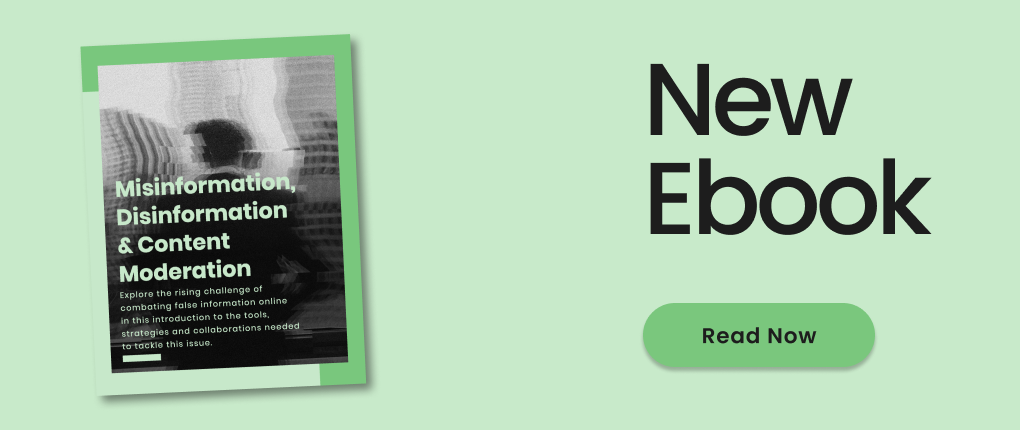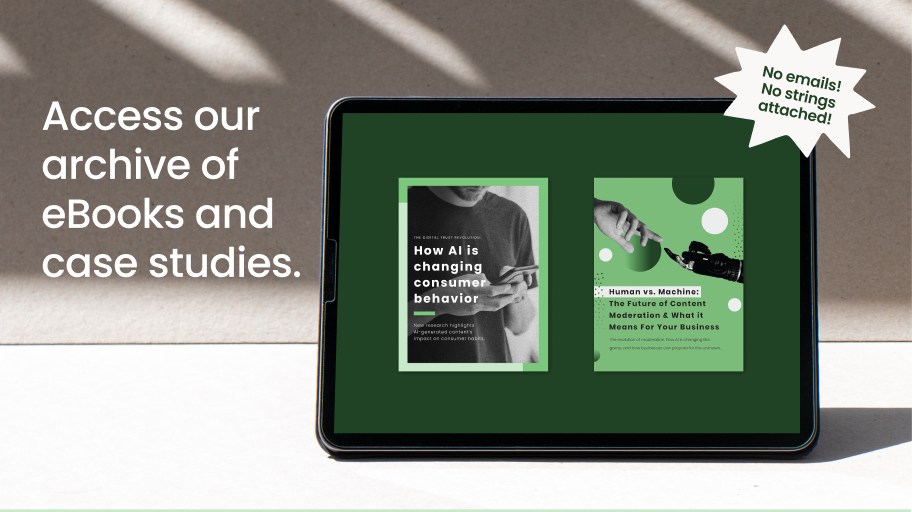The challenge of moderating a world awash in misinformation
January 22, 2024 | Marketing & OperationsAs we move into 2024 with its bevy of elections, continuing debates about climate change, COVID-19 and myriad other topics, people are facing information overload. The online world is one where the line between truth and fiction blurs daily, and the once-clear path of fact-checking is now a labyrinth, twisted by the sheer volume of content that bombards us relentlessly. Misinformation and disinformation doesn’t just trickle in; it floods our feeds, challenging our perceptions and beliefs.
Our new ebook, Misinformation, Disinformation & Content Moderation, aims to demystify the origins of such false information and explain the methods by which it pervades, while offering fresh perspectives and innovative solutions for platforms to stop it in its tracks. It’s a roadmap for navigating the complexities of content moderation, with advice from experts who have been on the front lines in the battle against fake news and synthetic media.
In this blog, we’ll explore some of the critical themes of the ebook, examining the multifaceted challenge of misinformation and the cutting-edge strategies needed to tackle it. From the intricacies of AI in content moderation to the empowering role of digital literacy and the concept of prebunking, our new ebook is an essential resource for anyone worried about the rise of false information online and wondering what can be done.
The Scale of Misinformation
In 2024, the online world is an expansive place where trillions of data points intersect, creating an environment that’s ripe for misinformation. Social media platforms, news websites, and various other digital channels churn out content at an unprecedented rate.
As we point out in our ebook, many platforms rely on flagging instances of misinformation on a case-by-case basis, which may work for a while but is ultimately a method impossible to scale and prone to human error. This deluge of information, coupled with the speed at which it travels, renders traditional fact-checking methods inadequate.
In recent years, we witnessed how misinformation can spread rapidly, influencing public opinion and shaping discourse on critical issues. From elections to public health crises, the impact of false information has far-reaching consequences. It has the power to sway elections, incite public unrest, and even endanger lives.
The rapid proliferation of misinformation also raises questions about the role of technology in information dissemination. As algorithms prioritize engagement over accuracy, sensational and misleading content often overshadows factual reporting. This dynamic is leading to a paradigm shift in how information is consumed and necessitates a rethinking of our approach to information moderation.
Limitations of Traditional Fact-Checking
Traditional fact-checking, while essential, is ultimately a reactive process – a response after misinformation is already disseminated. Human moderators, alone, despite their best efforts, cannot keep pace with the constant stream of digital content. This lag in verification means that by the time misinformation is identified and corrected, it likely already achieved its goal of reaching and influencing a vast audience.
The nature of misinformation is also often complex, requiring a deep understanding of context, culture, and language. Simple fact-checks might not be sufficient enough to unravel the intricacies of certain misleading narratives.
Additionally, there is a growing skepticism towards fact-checking entities, which can be perceived by some as biased or agenda-driven, further complicating the task of establishing truth in the public domain.
Innovative Approaches to Content Moderation
In response to these challenges, our ebook advocates for innovative methods such as source credibility labeling, a process where content is marked with indicators of its originating source’s trustworthiness. This approach empowers users to discern the reliability of information based on the credibility of its source.
It shifts some responsibility to the consumer, enabling them to make more informed decisions about the content they engage with. As our ebook suggests, this method allows users to decide whether a piece of content is worth sharing or trusting, based on its overarching editorial practices.
Source credibility labeling also addresses concerns around free speech and censorship. Rather than outright removal of content, which can lead to accusations of censorship, this method offers a nuanced approach that respects the right to free expression while promoting informed consumption of information.
In addition to source credibility labeling, our ebook emphasizes the importance of adding context to posts and encouraging community-based fact-checking. This strategy not only applies to news sites but extends to various types of online content where misinformation can spread.
By enabling users to contribute to fact-checking efforts, akin to initiatives like Twitter’s Community Notes and Wikipedia’s collaborative model, we harness the collective knowledge and vigilance of the community. This approach further empowers users to discern and challenge the veracity of information, fostering a more informed and responsible online environment.
Prebunking False Information
Prebunking is another proactive approach to combat misinformation by immunizing the public against false narratives before they spread. It involves educating people about common misinformation tactics, thereby building a form of psychological resilience.
As our ebook elaborates, “Prebunking is a technique employed to help people be less susceptible to misinformation techniques, focusing on building resilience by helping people identify potential deception tactics.”
Effective prebunking strategies can include the use of infographics, educational videos, and interactive online games that expose and debunk common misinformation tactics. These tools can help people recognize and resist emotionally charged or sensationalist content that often carries misleading or false information.
The objective is to foster critical thinking and a questioning mindset, making individuals less vulnerable to being swayed by false narratives.
The implementation of such methods as these requires a concerted effort from all stakeholders, including technology platforms, media organizations, and educational institutions. Educating the public about these new approaches is equally crucial, as it fosters a more discerning and critical online audience.
The Role of AI in Moderation
Artificial Intelligence (AI) presents promising prospects in aiding content moderation when scale becomes an issue. AI algorithms can quickly analyze vast amounts of data, identifying patterns and flagging potential misinformation. However, as our ebook cautions, AI is not a magic bullet.
Notably, the emerging ‘genAI’ threat — where AI-generated content is used to create sophisticated misinformation — poses a new frontier in content moderation. This underscores the need for AI to be used judiciously, as it can sometimes miss the subtleties and context that human moderators can discern.
AI’s role in moderation should be seen as complementary to human efforts. While it can enhance the speed and efficiency of identifying misinformation, human oversight is essential to ensure accuracy and context. This balanced approach, where AI supports but does not replace human judgment, is crucial in developing effective content moderation strategies.
The Need for a Multi-Faceted Approach
Combating misinformation in the digital age requires a multi-faceted strategy. This approach combines human moderation, AI tools, and user empowerment to create a robust system against misinformation. By leveraging the strengths of both human and technological resources, this comprehensive strategy addresses the complexity and scale of misinformation more effectively than traditional fact-checking alone.
A collaborative effort is essential, where different sectors work together to tackle misinformation. This includes media literacy education to empower users, technological innovations to enhance moderation, and policy frameworks.
“You’re not going to be an expert in everything, so make sure that you have good partners… who can help lean on third-party expertise,” James Alexander points out in our ebook. James is the former Global Head of Illegal Content & Media Operations at Twitter who’s experience combating the rise of misinformation in the last decade provides a unique perspective on the evolving challenges social media platforms face on an ongoing basis.
“The most likely problems will always be the simplest,” James notes, advocating for a moderation strategy that prioritizes the everyday experiences of the “99%.”
Find out more about James’s advice and experience, what other experts in the trust and safety industry are doing in response to the changing nature and sophistication of false information, as well as WebPurify’s own model for working with clients to fight misinformation at scale.

